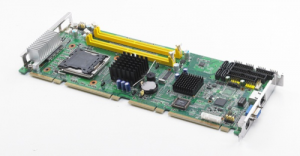 When the subject is industrial-grade single-board computers, most of us think of complete computer systems arranged on single circuit boards, but we also tend to think of processors offering only modest reliable performance. Because single-board computers are most often destined for embedded applications to control discrete functions within larger systems, the processors that serve as the hearts of these embedded systems need to be capable of no more than the modest demands of the particular task for which the system was dedicated.
When the subject is industrial-grade single-board computers, most of us think of complete computer systems arranged on single circuit boards, but we also tend to think of processors offering only modest reliable performance. Because single-board computers are most often destined for embedded applications to control discrete functions within larger systems, the processors that serve as the hearts of these embedded systems need to be capable of no more than the modest demands of the particular task for which the system was dedicated.
But the demands placed upon single-board computers have increased significantly in recent years as the functions these systems are designed to control have increased in both scope and complexity, requiring single-board options with ever-greater processing capacity. It is for this reason that Advantech offers extremely capable yet affordable single-board computers configured with Intel’s flagship processors, including its third-generation Core i7 processor.
The third-generation Ivy Bridge Intel core platform incorporates the Sandy Bridge micro architecture in conjunction with the smaller 22-nm process technology, which uses tri-gate transistors to provide higher performance at the same – and lower! – levels of thermal design power. These Ivy Bridge enhancements, together with USB 3.0 and PCIe 3.0, result in faster input/output.
Ivy Bridge accommodates memory up to DDR3-1600 and DDR3L-1333, resulting in lower power consumption, despite faster communication between components. The Ivy Bridge architecture also supports up to three independent displays and delivers a 50 % increase in 3D graphic performance.
USB 3.0 supports transmission speeds of up to 10-times faster than those of USB 2.0, which in turn reduces data transmission delays, as well as power consumption. For example, while USB 2.0 requires approximately 4 minutes 27 seconds to transfer an 8-GB DVD video at 480 megabits per second, USB 3.0 accomplishes the task in roughly 27 seconds thanks to its 5-gigabit per second transfer rate. This increased efficiency is primarily achieved by virtue of USB 3.0’s full-duplex technology, which allows for two-way data transmission, as opposed to USB 2.0’s half-duplex capability. Nevertheless, the USB 3.0 port is backward compatible with the many USB 2.0 devices still in service.
PCIe 3.0 supports a bit rate of 8 giga transfers per second, almost double the speed of PCIe 2.0. As the tasks to which single-board computers become increasingly graphic intensive, the greater capacity of PCIe 3.0 leaps ahead of those demands. PCIe 3.0 also supports scrambling, eliminating the need for 8-B and 10-B encoding. Of course, PCIe 3.0 is also backward compatible with devices from previous generations.













